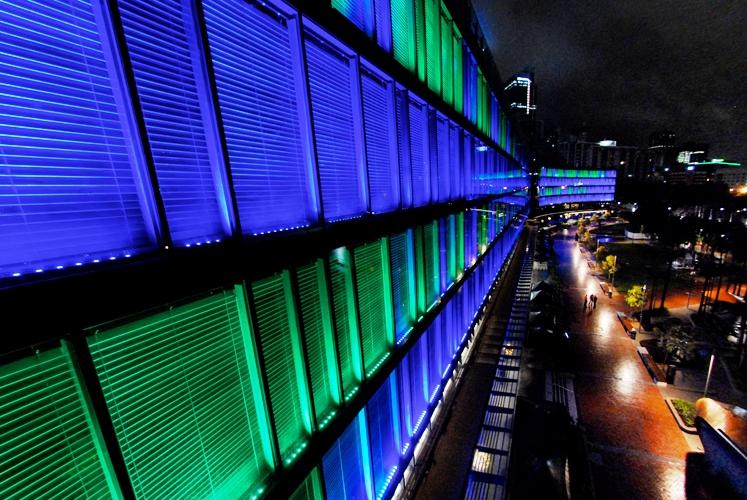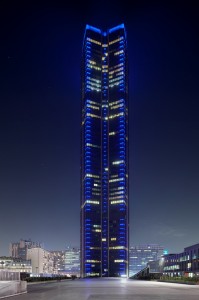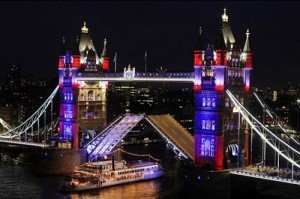LED Lighting Features Prominently In Architectural Design
Posted by Richard Clarke on 5th Jul 2012
Lighting is an important consideration when designing a building. Thanks to its incredibly low power consumption and high luminosity, LED lighting enables architects to balance factors such as functionality, aesthetics, energy-efficiency and cost with ever greater levels of success.
The following are just a few notable examples of how LED lights have been incorporated into architectural design projects:
Luminous, Darling Quarter, Sydney, Australia

Part of an extensive revitalisation project in Sydney's Darling Harbour (former site of the Sega World Centre), Luminous is, according to the Wall Street Journal “the world's biggest interactive permanent light display.”
Officially opened in the Darling Quarter Precinct in Sydney’s Central Business District on 18 May 2012, it was created by introducing hundreds of colour-changing LEDs into the windows of two campus-style buildings.
The colour of each window is controlled independently, effectively turning them into pixels.
During the week, the lights display calming animations of clouds and waves, but at the weekend these turn into an upbeat and dynamic visual display with which visitors to the area can interact using their smart mobile phones.
Montparnasse Tower, Paris, France

The Montparnasse Tower in Paris was, when it was finished, widely regarded as one of the ugliest buildings in the world.
Earlier this year, Royal Philips completed work on the renovation of its exterior lighting system.
Now the building boasts an impressive state-of-the-art DMX-controlled LED lighting system, allowing it to match its sceneography to the changing seasons.
Even more impressive, the lighting uses the same amount of energy as a small, domestic kitchen appliance.
The Empire State Building, New York, USA
Instantly recognisable all over the world, the Empire State Building recently traded in its old architectural light sources for an advanced LED system that’s capable of producing millions of colours.
Extending upwards from the 72nd floor to its mast, the lights will be switched on to commemorate key milestones, events, charitable organisations, countries and holidays throughout the world.
The former lighting setup was capable of achieving just 10 single colours, which could only be customised by the application of coloured gels.
“The LED system has 16.7 million colour possibilities, in digital combinations of ripples, sparkles, sweeps and strobes," says Phil O'Donnell, of Massachusetts-based Philips Color Kinetics, the company responsible for the system. "It's the sum of all possibilities - a huge palette,” he explained.
Tower Bridge, London, England

The renovation of Tower Bridge's antiquated lighting system was completed just in time for the Queen's Diamond Jubilee.
The bridge, which had formerly used static halogen floodlights, now has a state-of-the-art LED Lighting system, and will play a key role in the forthcoming London Olympic and Paralympic Games.
The new lights have slashed energy-consumption by an enormous 40% and, due to their extremely long life-expectancy, won't need to be replaced for many years.
Hardbrücke Bridge, Zurich, Switzerland
The Hardbrücke project in Zürich is reportedly the largest LED installation in Switzerland. The underside of the 2.3 kilometre bridge is illuminate with 1750 LED luminaires. These require 25 kW for 1,654 hours a year, or 41,000 kWh/yr in total.
Going into the project, the main goal was to upgrade the lighting beneath the bridge and provide greater security for pedestrians. The lighting system’s designers took into consideration cyclists and pedestrian pathways, as well as a newly-laid S-Bahn rapid-transit rail line and an additional public-transportation lane.
Reportedly, as well as fulfilling its original remit, the LED lights have also reduced Zürich’s energy requirements from 32 kW to 21 kW which means savings of 42,800 kWh/yr.
Maybe you’ve visited one of these incredible architectural applications for LED lights, so why not leave a comment below, or visit our Facebook or Twitter pages and mention it there?
And, if you’d like to find out about how LED lights can benefit you, please give one of our friendly and professional customer service advisors a ring on 0116 321 4120, or send an e-mail enquiry to cs@wled.co.uk.





